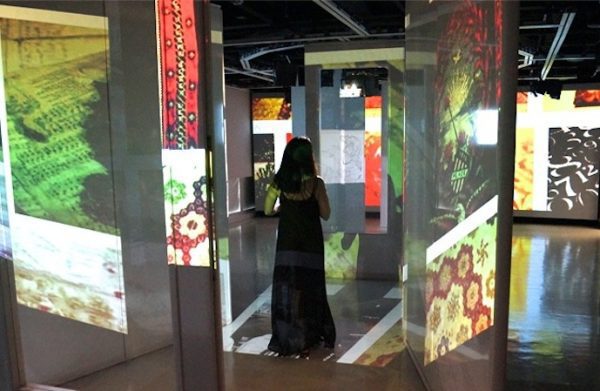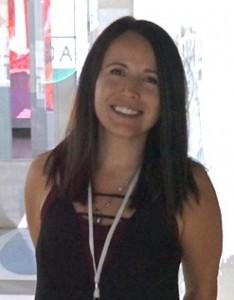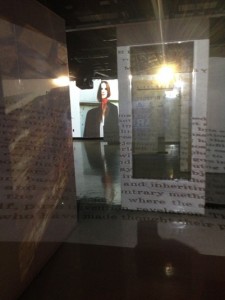Writing Faculty’s Digital Installation Featured in Film at Hunt Library

Footage of an immersive digital art installation designed by UNC Charlotte writing instructor Heather Marcelle Crickenberger will be featured for the coming year in a video that greets N.C. State University Hunt Library visitors.
The informational video, “Unleashing the Power of Visualization and Collaboration at the Hunt Library,” serves as an introduction to the library’s collaborative learning, game development, and visualization technologies. It debuted on March 3, 2015 and can be seen in the iPearl Immersion Theater at the library’s main entrance and on YouTube.
Crickenberger, a lecturer with UNC Charlotte’s University Writing Program, is shown in the film installing her presentation for the 2014 North Carolina Literary Festival, hosted by the Hunt Library in April 2014. Crickenberger had designed her presentation using augmented reality technologies.
 “Being familiar with Dr. Crickenberger’s theoretical and artistic work, I knew she was the perfect person to create an installation in the Hunt Library’s Creativity Studio centered around the North Carolina Literary Festival’s theme, The Future of Reading,” said Jason Jefferies, the library’s advanced user experience librarian and visualization consultant.
“Being familiar with Dr. Crickenberger’s theoretical and artistic work, I knew she was the perfect person to create an installation in the Hunt Library’s Creativity Studio centered around the North Carolina Literary Festival’s theme, The Future of Reading,” said Jason Jefferies, the library’s advanced user experience librarian and visualization consultant.
“She took a blank space with a very nebulous structure and transformed it into a phantasmagorical multimedia-based walkthrough experience, the likes of which had not yet been executed in our library’s hi-tech space,” Jefferies said.
Duke University Libraries, the University of North Carolina at Chapel Hill Libraries, and the NCSU Libraries host the festival on a rotating basis. Last year’s event featured readings, performances, interactive exhibitions, and multimedia presentations by prominent authors including Junot Díaz, Peter Straub, Richard Ford, and William T. Vollmann. It also hosted North Carolina authors and librarians including Therese Anne Fowler and Jeff Jackson.
Crickenberger traveled to the Hunt Library several times to consult with library staff and to experiment with the projection apparatus in the Creativity Studio. She titled her exhibit “Projections: Exploring Reading and Writing in Emerging Technologies (or How an Apparatus Becomes Self-Aware).”
The exhibit projected digital content through 10 video displays onto more than 20 moveable display surfaces. The videos featured flashing slideshows of artistically edited advertisements, digital artifacts, propaganda, and excerpts of texts collected from what she calls “photographing wanderings in the World Wide Web.”
Crickenberger said she used the genre of artistic installation to explore how visualization technologies could be applied to the visual arts and used to form new ways of writing.
“I wanted to draw the audience’s attention to the digitally-augmented qualities of everyday life and to ask them to think critically about the texts that make up the world they inhabit and the forces they exert, even when only fleeting and in the background,” she said.
Crickenberger has taught writing and literature in UNC Charlotte’s Department of English and University Writing Program since 2007 and is technical writing advisor to the Mechanical Engineering and Engineering Science Department. As she teaches writing, she works with students composing in new media.
Project Research Changes Teaching Approach
“The festival project has changed the way I think about teaching writing,” she said. “In the Creativity Studio, I was able to design a text that was three-dimensional, inhabitable, and in flux, and experiencing this helped me see parallels in the writing I ask my students to do every day.”
“As I moved the studio’s panels around on the tracking system, trying to find the right formats and configurations for my content, I found myself asking a lot of questions about writing—like, what happens when a page is not flat or fixed, or if several pages overlap or reflect onto one another, or if the reader is not sitting still?” she said. “These are all questions I now ask my students. I ask them to think about writing as design, as creativity within constraints.”
The University Writing Program is exploring immersive writing environments by using classrooms lined with multiple video displays and collaborative writing surfaces.
“When we use these technologies we help students see writing as design, and that’s something transferable to many disciplines,” Crickenberger said. “Whether you’re designing a document to be published in a journal or a poster session, or writing a poem, if you’re working creatively within a set of limitations, you’re using design thinking. I’m excited to see where it leads.”
 Crickenberger’s festival project drew on the writings of cultural theorist Walter Benjamin, particularly those from the 1930s concerning the flâneur and the Parisian arcades of the 19th century. In her web-based doctoral dissertation, The Arcades Project Project or The Rhetoric of Hypertext, Crickenberger had used the image of the flâneur in the arcades of Paris as a way to look at the way readers and scholars function in hypermedia.
Crickenberger’s festival project drew on the writings of cultural theorist Walter Benjamin, particularly those from the 1930s concerning the flâneur and the Parisian arcades of the 19th century. In her web-based doctoral dissertation, The Arcades Project Project or The Rhetoric of Hypertext, Crickenberger had used the image of the flâneur in the arcades of Paris as a way to look at the way readers and scholars function in hypermedia.
She defined the flâneur as an idler, a stroller. “He has been portrayed in the past as a well-dressed man, strolling leisurely through the Parisian arcades of the nineteenth century – a shopper with no intention to buy.”
The arcades were improvised structures, early ancestors of shopping malls, department stores, and their virtual counterparts on the web today. They emerged throughout Paris, as advances in iron and glass construction enabled merchants to transform streets into glass-roofed refuges for customers in bad weather.
“It is this image of the flâneur, wandering the carefully-constructed dream-like world of the arcades, that embodies the situation faced by readers in the modern world,” Crickenberger said.
Her project for the literary festival extended this image of readers wandering through text to that of readers wandering through digitally augmented environments. During the festival, visitors were invited to explore the passage-like space of shifting text and disrupted images as 21st century flâneurs, wandering through a textual construction and sharing photographs and their own perspectives through social media
.
For the visitors, like the writers in Crickenberger’s classes, the journey can lead to new and deeper understandings of writing.